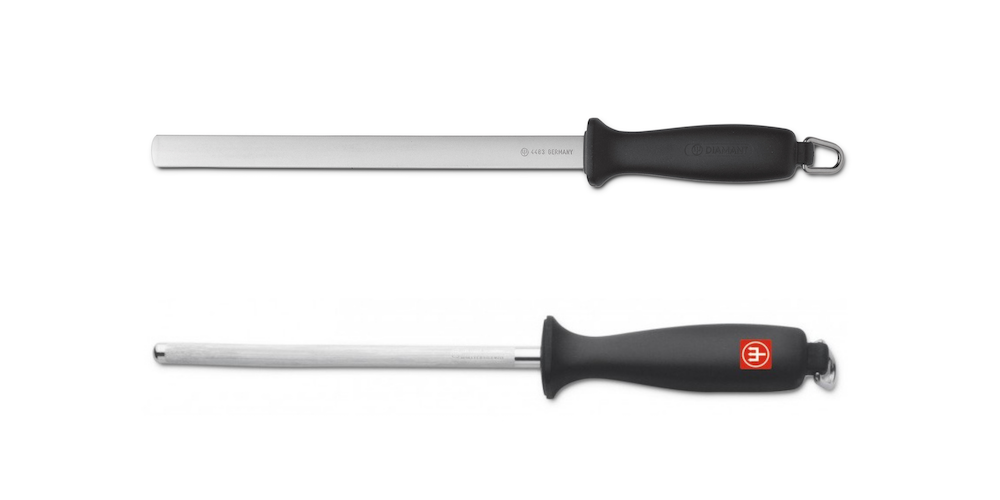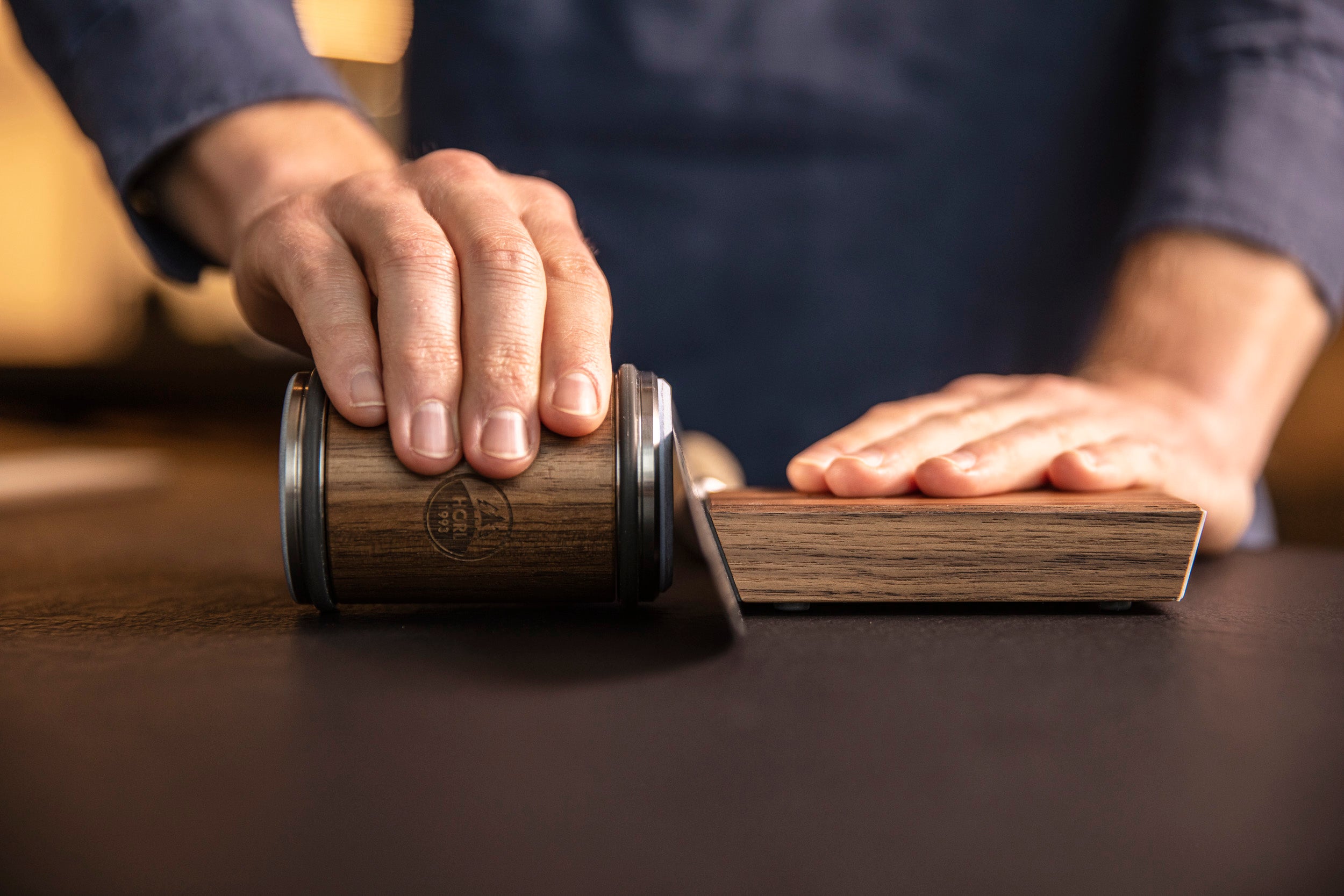Whetstones, Steels, Pull-Through Sharpeners: What’s Best?
Before we go into the three most popular ways to sharpen a knife, let’s cover the basics.
Sharpening vs. Honing
Think of the edge of your knife’s blade as a row of teeth. The more you use the blade, the more those teeth break off and misalign. So when you sharpen your knife, what you’re doing is fixing those teeth and getting it back into a neat row, so they can chop onions, dice chicken, and chiffonade herbs quickly and neatly, reducing any chance of slippage (and a visit to A&E).When you sharpen a knife, you need to do two things: sharpen and hone. Sharpening fixes knicks and chips on the blade, while honing re-aligns those ‘teeth’ so they are in a neat row. You should never sharpen a knife without honing it, as sharpening fixes the nicks but does not reinstate the edge – which means your knife won’t be sharp. Honing is what reinstates the edge to get your knife in cutting edge condition. And if you *really* want to hone your knives to perfection, consider a polishing strop or finishing leather.
You can hone a knife without sharpening it. Some chefs choose to do this after every use. It’s a matter of maintenance rather than sharpening. How you can tell whether your knife needs sharpening and honing or just a honing is: Does it cut through a tomato neatly and easily? If it’s very messy, sharpen the knife. If it’s on the neater side, then just honing will do.
To clarify: When anyone, including us, says ‘sharpen a knife’, what they mean is ‘sharpen and hone’ a knife, not one or the other (unless specified).

Whetstones
Whetstones are made from natural stone that, when wet, acts like sand, allowing the blade more movement, so it sheds the least amount of metal possible. It also 'respects' the shape of your blade, because when you use a whetstone, you have to find the precise angle of your knife's blade, then move it along that precise angle when you sharpen and hone. Unlike sharpeners that set a blade angle for you, like pull-through sharpeners, you are responsible for finding the precise angle of your knife's edge when using a whetstone. This takes practice, and you have to be careful, as using a whetstone incorrectly could weaken or damage a blade's edge. It can be fixed, but still – practice and caution are key.
Using a whetstone also requires a small time commitment. You have to set aside 15 minutes to submerge the stone in water, then sharpen each knife on both sides of the blade (unless it is a single-edged blade), then turn the stone over and hone the knives on both sides of the blade. Start to finish, especially if your knives are dull, the process takes at least 30 minutes. Many cooks cherish this meditative experience, but others prefer the quickness and convenience of other sharpening methods. If you’re only honing your knives, it will take a bit less time, as you'll only be using one side of the whetstone (higher grit).
How often you use the whetstone comes down to how much work you put your knives through. Digital Content Editor Kelly, who cooks with her partner every day, tends to use a whetstone once a month. The best way to tell when a knife needs sharpening is to try and slice a tomato with it. Does it slice neatly, and feel easy to do so? It's in good shape. Does the tomato squish under the blade, and splutter juice around the chopping board? It needs sharpening.
Verdict: If you want the edge of your knife blade to be as close to its original angle as possible, use a whetstone. Since it's the gentlest way to sharpen a knife, it extends the durability of knife blade — as long as you use it properly. Just know that it requires practice and some time commitment. We've noticed that chefs and knife aficionados gravitate towards whetstones, as they are most finely attuned to the nuances of the way a blade cuts.

Sharpening Steels
First things first: There are sharpening steels, and there are honing steels. If you want to use steels as your primary method of sharpening knives, you’ll need both. However, if you’re looking to just maintain a sharp-enough knife’s edge—in between whetstone sessions, for example—then you just want a honing steel.Since steel is a much harder and more inflexible material than stone, it sheds more metal than a whetstone. However, it is much less abrasive than a pull-through sharpener. That’s because it is not designed to shape a knife’s edge the way a pull-through is (more on that soon).
We do not recommend using sharpening or honing steels on Japanese knives. That’s because Japanese knives are made from very hard steel — alongside the tapered V shape, this harder steel contributes to the effortless feel of Japanese knives. This makes the steel more brittle, and thus the contact of a Japanese metal blade with a metal sharpening or honing steel — especially diamond steels — could cause it to chip.
It’s also very difficult to get the angle correct when using a steel. On a whetstone, which is freestanding, you can use both your hands to press a knife’s blade against the stone to determine the exact angle (that’s what we mean by ‘respecting the shape’). However, when you use a sharpening or honing steel, you have to have one hand on the handle of the steel and another on the handle of the knife. This process is much more forgiving on a Western-style blade, which is made of softer metal that is more compatible with sharpening or honing steels.
Verdict: Use sharpening or honing steels on Western knives. Honing steels, in particular, are an excellent option for maintaining your knife’s edge between more rigorous sharpening sessions on a whetstone or pull-through sharpener. Note that steels marked ‘Diamond’ are intended for sharpening.

Pull-Through Sharpeners
Pull-through sharpeners are the most popular way to sharpen knives, and with good reason: They are quicker than whetstones and more precise than sharpening steels. However, they shed the most amount of metal, which weakens the durability of knives.Most pull-through sharpeners include two pre-set shapes in them, with a slot for sharpening and a slot for honing. When you pull a knife through these slots, they sharpen or hone a knife’s edge by grinding it into that pre-set shape. This makes it super sharp in an instant, and re-aligns them to their original shape. That’s why it’s important to make sure that your pull-through knife sharpener is compatible with your knife. Most German knives have similar shapes, angles, and metals, and thus these knives and pull-through sharpeners could be used interchangeably, but it’s safest to stay within the brand. Using a Wusthof pull-through sharpener for Wusthof knives, for example, is a great option.
However, it does shed a lot of metal, so use it sparingly. Your knife will still last several years, but not as long as if you use a whetstone or steels.
Verdict: If you want something quick, simple, and powerful, a pull-through sharpener will do the job. (Ideally, it should be from the same company as the knife you will use it on).
The Best All-Round Sharpener

There are two pieces to the HORL 3 sharpener: A roller with two whetstones on each side (a coarse sharpening stone and a smooth honing stone), and a magnetic angle support. The magnetic angle support is also double-sided: one side sets the angle to 15° (suggested for Japanese knives), and the other sets it to 20° (suggested for Western knives). Simply attach the knife to the angle support, blade side up, at either 15° or 20°, and roll the sharpening and/or honing stone against the length of the blade a few times, depending on how dull your knife is. Repeat for the other side and do the tomato test. Sharpen more if needed. And that's it! To read more about how HORL 3 sharpener works, read our full review here.
Verdict: While we still believe whetstones are still the gentlest way to sharpen a knife, and the best way to respect a knife's original edge, we think the HORL 3 sharpeners is the best all-rounder for home cooks.















